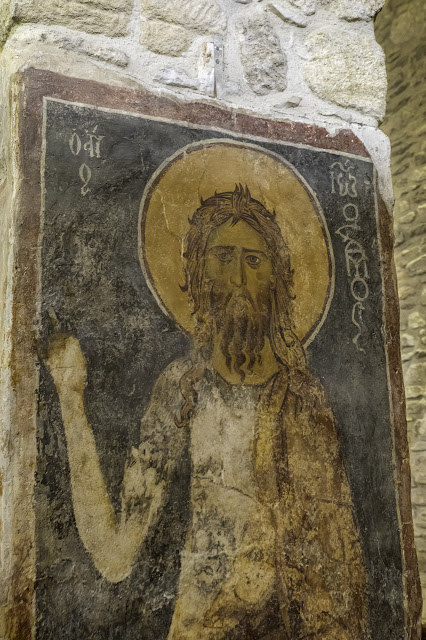The church of Panagia (Our Lady) tis Aggeloktistis is situated in the northwestern
end of the village of Kiti, 12 kilometres to the northwest of the city
of Larnaka and the ancient city of Kition. It was built in the 11th
century over the ruins of a 5th century early Christian basilica. The
basilica had a semi-circular synthronon, still surviving in the bema of
the 11th century church. According to local tradition, the residents of
ancient Kition moved to Kiti in order to escape the Arab invasions. In
Kiti they decided to erect a church in honour of the Virgin (Panagia).
While building the church, they realised that the foundations had moved
to a different location overnight. After the miracle had occured the
villagers then changed the location of the church and noticed that an
army of angels was coming down at night to build it; hence the name ’Aggeloktisti’ (‘built
by Angels’). The architectural plan of the church belongs to the type
of the domed, cross-in-square structure. Its current form is a result of
later additions and alterations. In the 12th century, a barrel-vaulted
parekklesi (chapel) was built to the north of the temple, dedicated to
the healer saints Anargiroi, Kosmas and Damianos. Medieval tombs were
found outside the northern side of the chapel, and it is possible that
it had a funerary character. In the end of the 13th/beginning of the
14th century, another chapel (the so-called Latiniko parekklesi (Latin
Chapel), was built to the south of the church of Panagia, in order to
serve the religious needs of the then rulers of Cyprus. Three
coats-of-arms still survive above the chapel’s entrance. One of them
belongs to the rich Frankish family Gibelet, owners of the chapel. The
inscribed tombstone of Simone Renier de Gibelet, who died in 1302 still
survives inside the chapel. It is quite possible that the chapel was
contemporary to her burial and that it also had a funerary character.
The interior of the church is decorated with significant frescoes of the
13th century, icons dated to various periods and the famous mosaic of
Panagia tis Aggeloktistis. The mosaic is on the conch of the apse,
inside the bema. It is considered to be one of the most significant and
elaborate wall mosaics of Early Christian art. It depicts the Virgin
standing, holding baby Jesus in her left arm, with the Archangels
Michael and Gabriel on either side. It is the oldest, surviving
monumental representation of the standing Panagia Aristerokratousa. On
the inscription she is referred to as “H AGIA MARIA” (Holy Mary).
source Department of Antiquities www.mcw.gov.cy/mcw/da/da.nsf
The purpose of the blog is to show my photographs from the places I visited and share some basic information about those places. If you have any question for the photos or the places or any other related please contact me petros.monogios@gmail.com
Subscribe to:
Post Comments (Atom)
Liban Quarry
The exploitation of limestones has been carried out here since the fourteenth century, and the oldest part of the quarry called "Za ...

-
In the central part of Cyprus, in the mountains of the Troodos range, some of the most important monuments of the history of Byzantine p...





































No comments:
Post a Comment